9-3 The Sun’s outer layers are the photosphere, chromosphere, and corona
Although the Sun’s core is hidden from our direct view using telescopes, we can capture sunlight coming from the high-temperature gases that make up the Sun’s atmosphere. These outermost layers of the Sun prove to be the sites of truly dramatic activity, much of which has a direct impact on our planet. By studying these layers, we gain further insight into the character of the Sun as a whole.
Observing the Photosphere
A visible-light photograph like Figure 9-5 makes it appear that the Sun has a definite surface. This is actually an illusion—the Sun is gaseous throughout its volume because of its high internal temperature, and the gases simply become less and less dense as you move farther away from the Sun’s center.
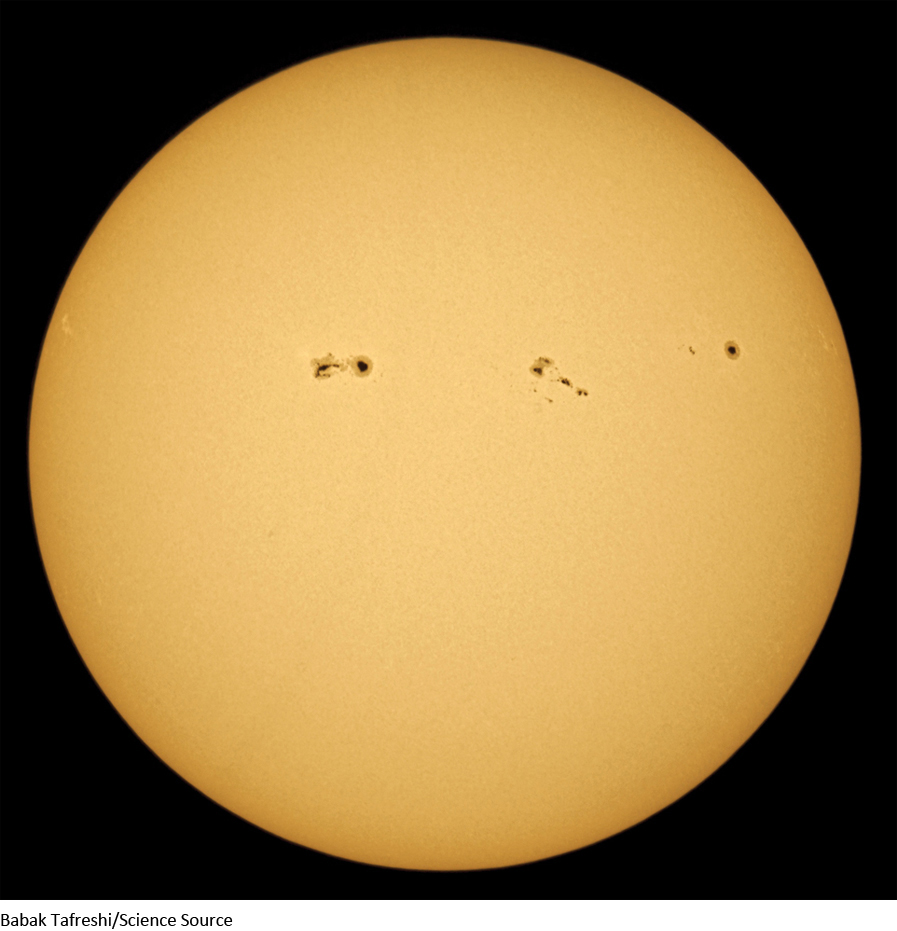
213
Why, then, does the Sun appear to have a sharp, well-defined surface? The reason is that essentially all of the Sun’s visible light emanates from a single, thin layer of gas called the photosphere (“sphere of light”). Just as you can see only a certain distance through Earth’s atmosphere before objects vanish in the haze, we can see only about 250 miles (400 km) into the photosphere. This distance is so small compared with the Sun’s radius of 865,000 mi (696,000 km) that the photosphere appears to be a definite surface. Although this is an arbitrary line, astronomers usually define everything beneath the photosphere as the Sun’s interior and everything above the photosphere as the Sun’s atmosphere.
Although the photosphere is a very active place, it actually contains relatively little material. It has a density of only about 10−4 kg/m3, roughly 0.01% the density of Earth’s atmosphere at sea level. The photosphere is made primarily of hydrogen and helium, the most abundant elements in the solar system. Despite being such a thin gas, the photosphere is surprisingly opaque to visible light. If it were not so opaque, we could see into the Sun’s interior to a depth of hundreds of thousands of miles, instead of a mere 250 mi.
We can learn still more about the photosphere by examining it with a telescope—but only when using special dark filters to prevent eye damage. Looking directly at the Sun without the correct filter, whether with the naked eye or with a telescope, can cause permanent blindness! Under good observing conditions, astronomers using such filter-equipped telescopes can often see a blotchy pattern in the photosphere (Figure 9-6). Each light-colored granule measures about 600 mi (1000 km) across—equal in size to the areas of Texas and Oklahoma combined—and is surrounded by a darkish boundary. The difference in brightness between the center and the edge of a granule corresponds to a temperature drop of about 300 K.
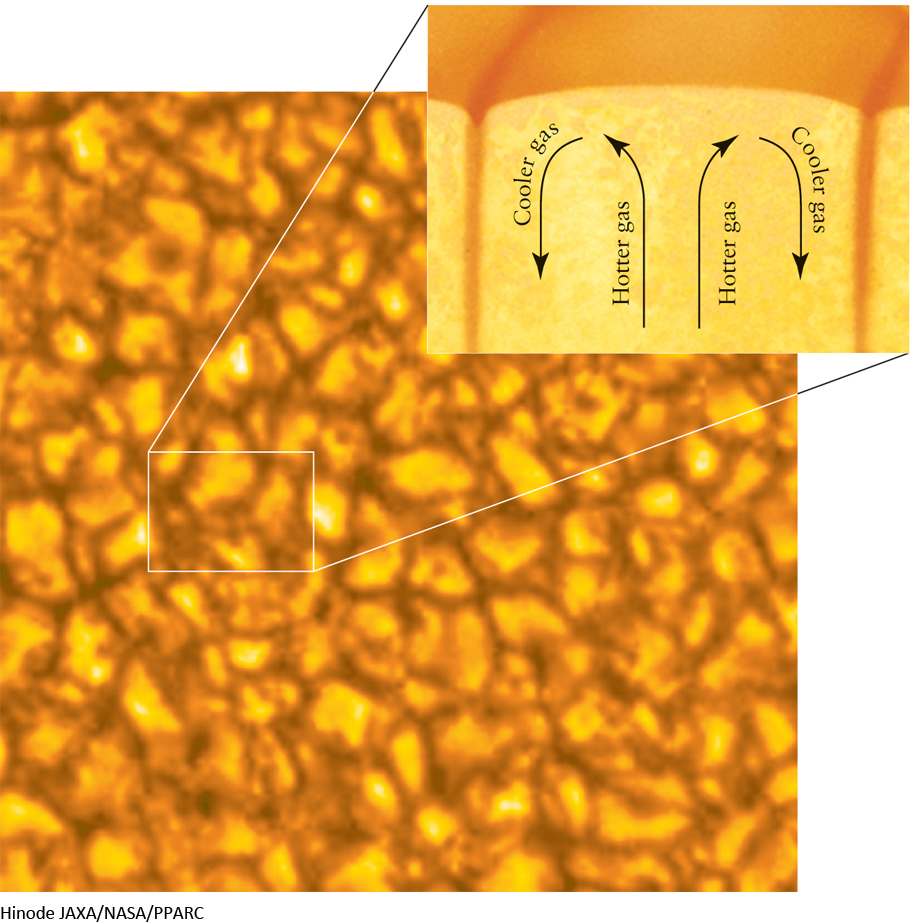
This granulation appearance is caused by convection of the gas in the photosphere. The inset in Figure 9-6 shows how gas from lower levels rises upward in granules, cools off, spills over the edges of the granules, and then plunges back down into the Sun. This can occur only if the gas is heated from below, like a pot of water being heated on a stove. Granules form, disappear, and reform in cycles lasting only a few minutes. At any one time, about 4 million granules cover the solar surface.
Superimposed on the pattern of granulation are even larger cells, or supergranules, that are about 20,000 miles (35,000 km) across, large enough to enclose several hundred granules (Figure 9-7). This large-scale convection moves at only about 900 mi/h (1400 km/h), about one-tenth the speed of gases churning in a granule that can last about a day.
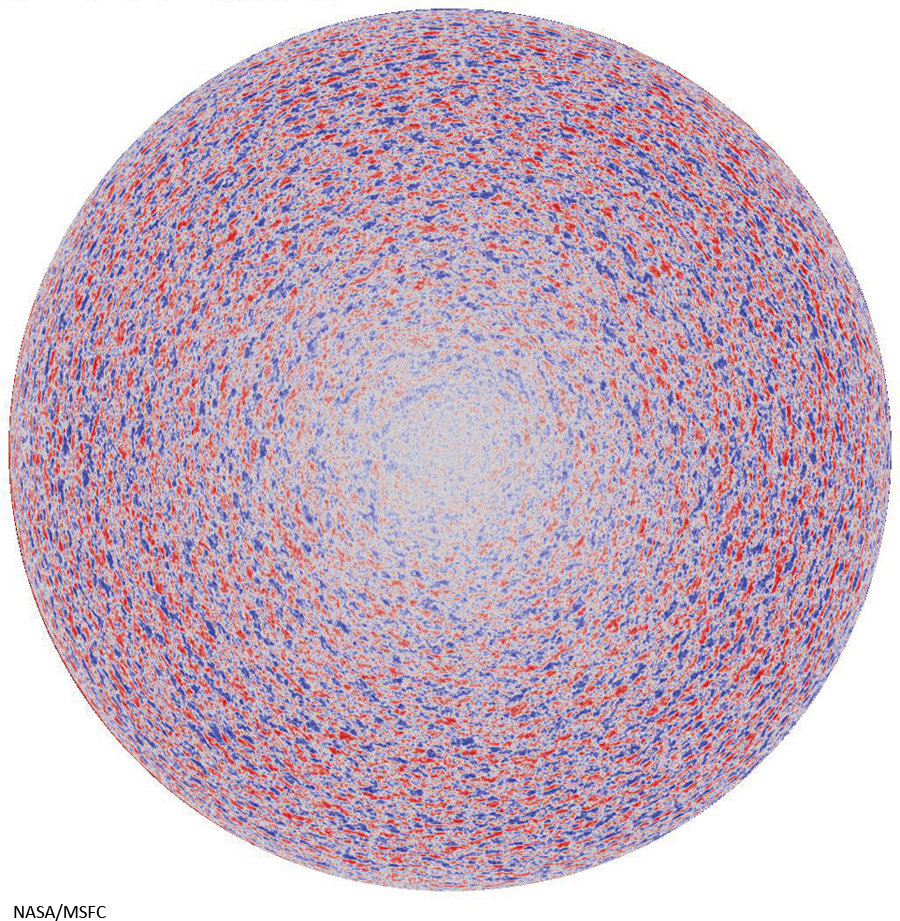
ANALOGY
Similar patterns of large-scale and small-scale convection can be found in Earth’s atmosphere. On the large scale, air rises gradually at a low-pressure area, and then sinks gradually at a high-pressure area, which might be hundreds of kilometers away. Thunderstorms in our atmosphere are small but intense convection cells within which air moves rapidly up and down. Like granules, they last only a relatively short time before they dissipate.
Question
ConceptCheck 9-10: What causes the photosphere to bubble like water boiling on the stove?
214
The Sun’s Chromosphere
 Go to Video 9-2
Go to Video 9-2
An ordinary visible-light image such as Figure 9-5 gives the impression that the Sun ends at the top of the photosphere. But during a total solar eclipse, the Moon blocks the photosphere from our view, revealing a glowing, pinkish layer of gas above the photosphere (Figure 9-8). This is the tenuous chromosphere (“sphere of color”), the second of the three major levels in the Sun’s atmosphere. The chromosphere is only about one ten-thousandth (10−4) as dense as the photosphere, or about 10−8 as dense as our own atmosphere. No wonder it is normally invisible!
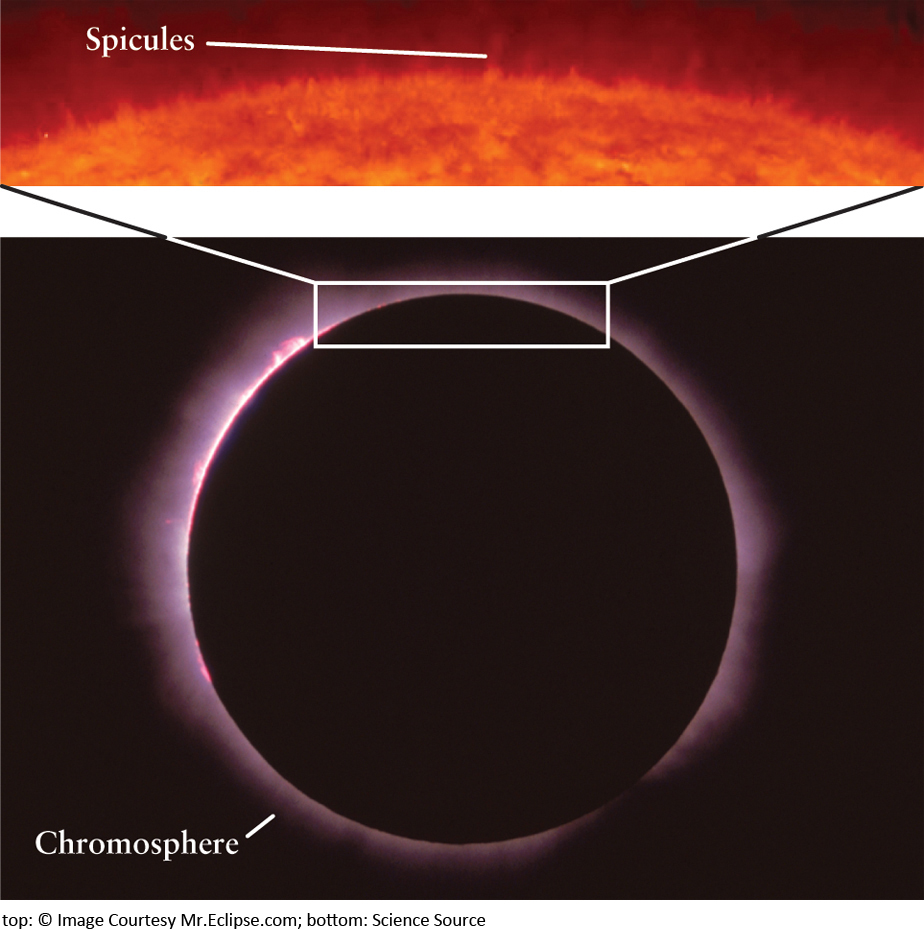
Named after the Sun god Helios, the element helium was first discovered in the Sun’s chromosphere long before it was found to exist on Earth.
Unlike the photosphere, which has an absorption line spectrum, a spectrum observed from studying gases in the chromosphere is dominated by emission lines. One of the most obvious emission lines in the chromosphere’s spectrum is the Ha line at 656.3 nm, which is emitted by a hydrogen atom when its single electron falls from the n = 3 level to the n = 2 level. This wavelength is in the red part of the spectrum, which gives the chromosphere its characteristic pinkish color. The spectrum also contains emission lines of ionized helium. In fact, helium was originally discovered in the chromospheric spectrum in 1868, almost 30 years before helium gas was first isolated on Earth.
What might be most surprising about the chromosphere is that the temperature increases with increasing height in the chromosphere. This is just the opposite of the situation in the photosphere, where temperature decreases with increasing height. This is very surprising, since temperatures should decrease as you move away from the Sun’s interior. In fact, though, the temperature is about 10,000°F (5800 K) at the top of the photosphere; just 1250 mi higher, at the top of the chromosphere, the temperature rises incredibly to nearly 50,000°F (28,000 K).
The top photograph in Figure 9-8 is a high-resolution image of the Sun’s chromosphere, usually only seen through an Ha filter. This image shows numerous vertical spikes, which are actually jets of rising gas called spicules. A typical spicule lasts just 15 minutes or so: It rises at the rate of about 45,000 mi/h (72,000 km/h), can reach a height of several thousand miles, and then rapidly collapses and fades away (Figure 9-9). Approximately 300,000 spicules exist at any one time, covering about 1% of the Sun’s surface.
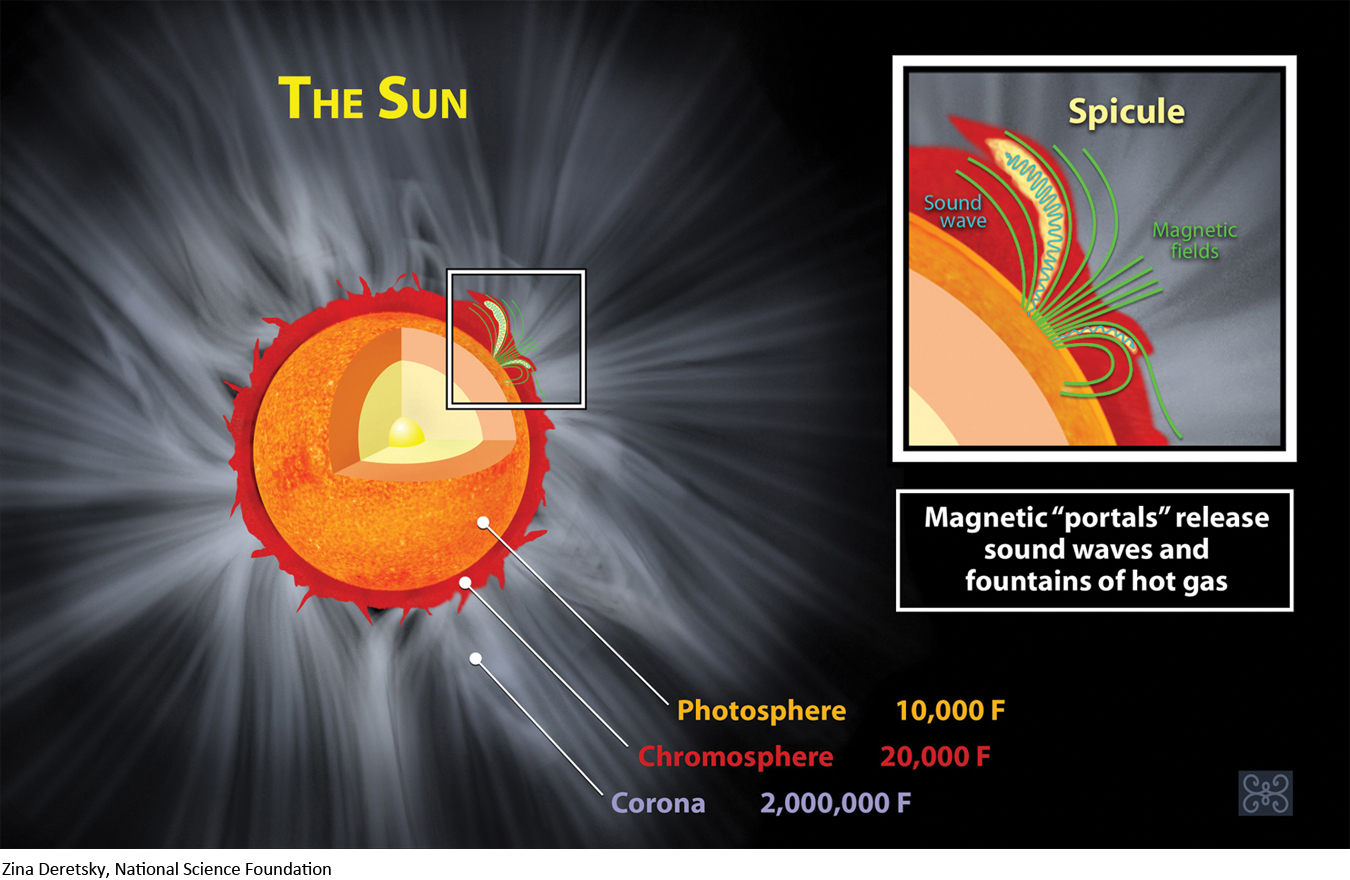
215
Spicules are generally located directly above the edges of granule groups. This is a surprising result, because chromospheric gases are rising in a spicule while photospheric gases are descending at the edges of granule groups. What, then, is pulling gases upward to form spicules? The answer proves to be the Sun’s intense magnetic field, which we discuss in Sections 9-4 and 9-5.
Question
ConceptCheck 9-11: How tall are spicules in the Sun’s chromosphere: the height of tall buildings, the distance between large nearby cities, or the distance across the entire United States?
The Corona
The outermost region of the Sun’s atmosphere begins at the top of the chromosphere. Called the corona, it reaches out to an enormous distance more than several times the diameter of the Sun. Despite its tremendous extent, the corona is only about one-millionth (10−6) as bright as the photosphere—no brighter than the full moon. Hence, the corona can be viewed only when the light from the photosphere is blocked out by the eclipsing Moon during a total eclipse or by the use of a specially designed telescope that can block the majority or the photosphere.
Figure 9-10 is an exceptionally detailed photograph of the Sun’s corona taken during a solar eclipse. It shows that the corona is not merely a spherical shell of gas surrounding the Sun. Rather, numerous streamers extend in different directions far above the solar surface. The shapes of these streamers vary on timescales of days or weeks. The temperatures in the corona are extremely high considering how far it is from the Sun’s core—temperatures can reach 5 billion degrees Fahrenheit or 3 million Kelvins—far greater than the temperatures in the chromosphere. Figure 9-11 shows how temperature in both the chromosphere and corona varies with altitude.
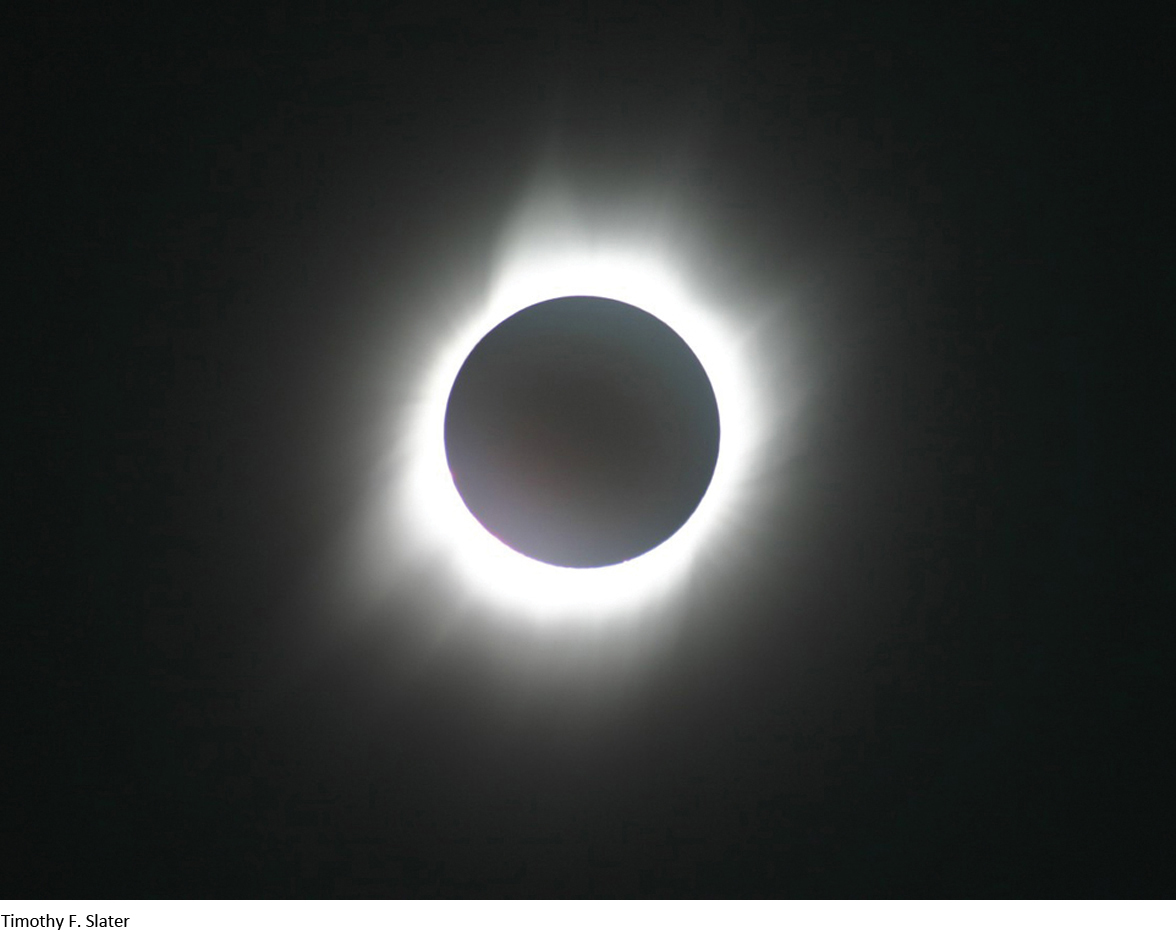
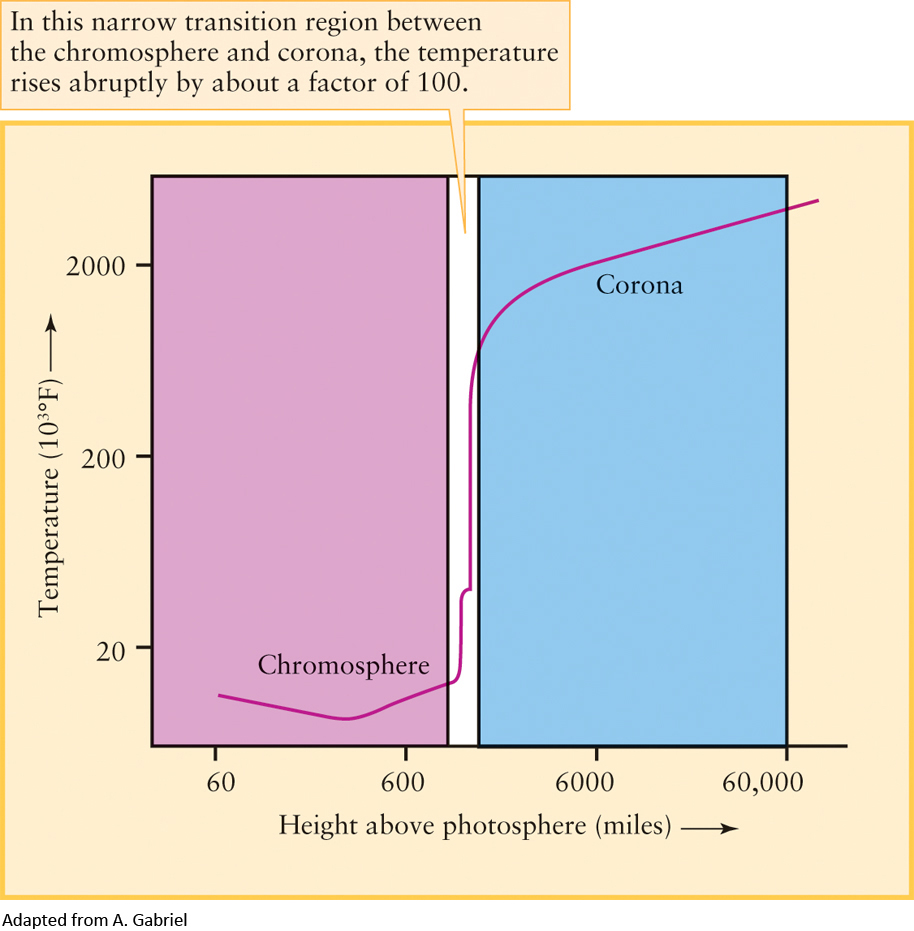
CAUTION
The corona is actually not very “hot”—that is, it contains very little thermal energy. The reason is that the corona is nearly a vacuum. In the corona there are only about 1011 atoms per cubic meter, compared with about 1023 atoms per cubic meter in the Sun’s photosphere and about 1025 atoms per cubic meter in the air that we breathe. Because of the corona’s high temperature, the atoms there are moving at very high speeds. But because there are so few atoms in the corona, the total amount of energy in these moving atoms (a measure of how “hot” the gas is) is rather low. If you flew a spaceship into the corona, you would have to worry about becoming overheated by the intense light coming from the photosphere, but you would notice hardly any heating from the corona’s ultrathin gas.
ANALOGY
The situation in the corona is similar to that inside a conventional oven that is being used for baking. Both the walls of the oven and the air inside the oven are at the same high temperature, but the air contains very few atoms and thus carries little energy. If you put your hand in the oven momentarily, the lion’s share of the heat you feel is radiation from the oven walls.
216
The low density of the corona explains why it is so dim compared with the photosphere. In general, the higher the temperature of a gas, the brighter it glows. But because there are so few atoms in the corona, the net amount of light that it emits is very feeble compared with the light from the much cooler, but also much denser, photosphere.
Question
ConceptCheck 9-12: Why is the corona so difficult to see if it is so much hotter than the photosphere?
The Solar Wind and Coronal Holes
 Go to Video 9-3
Go to Video 9-3
Earth’s gravity keeps our atmosphere from escaping into space. In the same way, the Sun’s powerful gravitational attraction keeps most of the gases of the photosphere, chromosphere, and corona from escaping. But the corona’s high temperature means that its atoms and ions are moving at very high speeds, nearly a million miles per hour. As a result, some of the coronal gas can and does escape the Sun’s gravitational attraction. This outflow of gas, is called the solar wind.
Each second the Sun ejects about a million tons of material into the solar wind. But the Sun is so massive that, even over its entire lifetime, it will eject only a few tenths of a percent of its total mass. The solar wind is composed almost entirely of electrons and nuclei of hydrogen and helium. About 0.1% of the solar wind is made up of ions of more massive atoms, such as silicon, sulfur, calcium, chromium, nickel, iron, and argon. The aurorae seen at far northern or southern latitudes on Earth are produced when electrons and ions from the solar wind enter our upper atmosphere.
Figure 9-12 reveals that the corona is not uniform in temperature or density. The densest, highest-temperature regions appear bright, while the thinner, lower-temperature regions are dark. This large dark area, which is not emitting much light, is called a coronal hole because it is almost devoid of luminous gas. But this does not mean this region is empty. On the contrary, high-speed particles streaming away from the Sun can most easily flow outward through these particularly thin regions. Therefore, it is thought that coronal holes are the main corridors through which particles of the solar wind rapidly escape from the Sun and flow across the solar system.
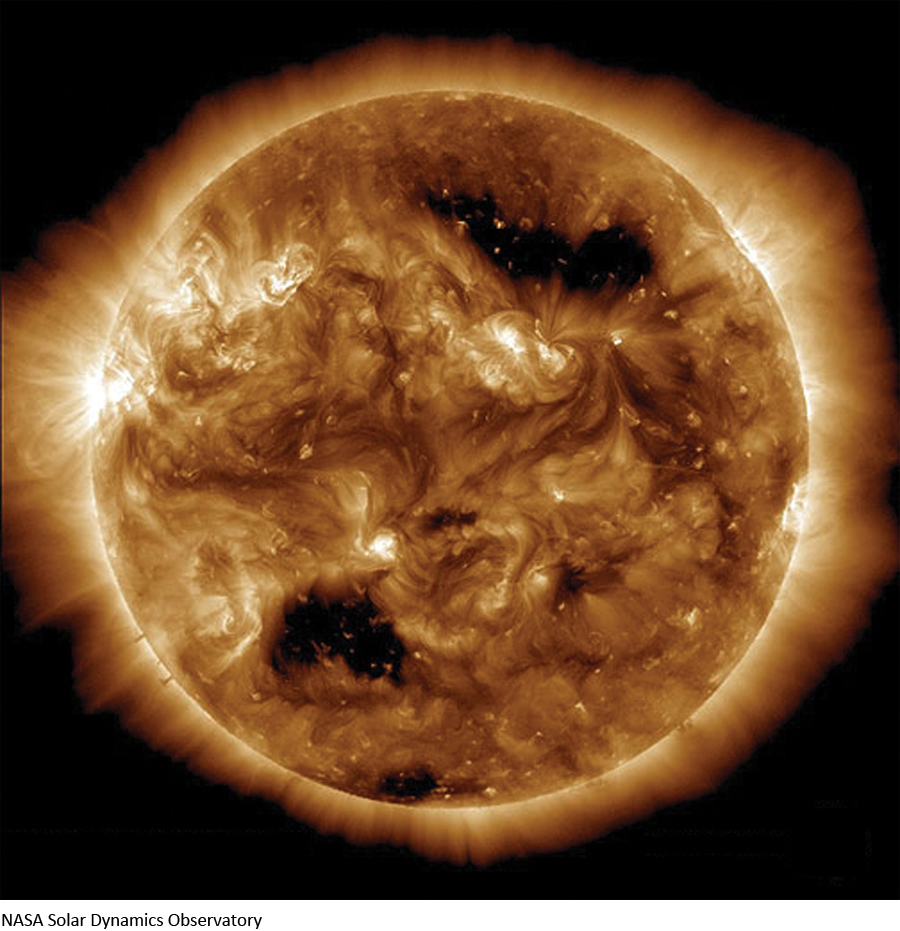
Sunspots appear dark because they are at a lower temperature than the surrounding regions of the Sun.
The surprisingly high temperatures in the corona and the chromosphere are not at all what we would expect. Just as you feel warm if you stand close to a campfire but become colder the farther away you move, we would naturally expect that the temperature in the corona and chromosphere would decrease with increasing distance from the photosphere. Why, then, does the temperature in these regions increase with increasing altitude? This has been one of the major unsolved mysteries in astronomy for the past half-century. As astronomers have tried to resolve this dilemma, they have found important clues in one of the Sun’s most familiar features—sunspots.
Question
ConceptCheck 9-13: From where on the Sun does the solar wind seem to emanate?